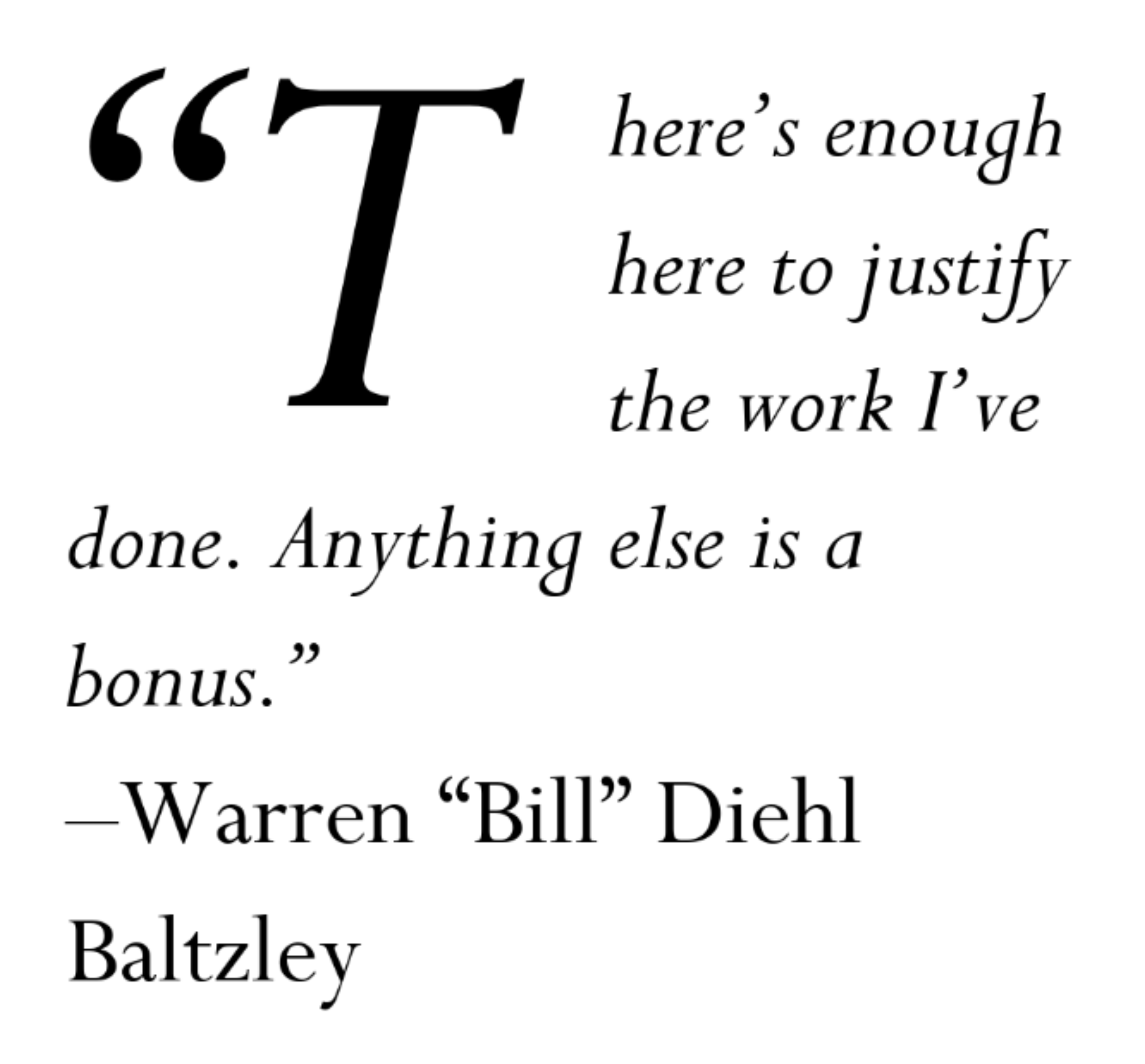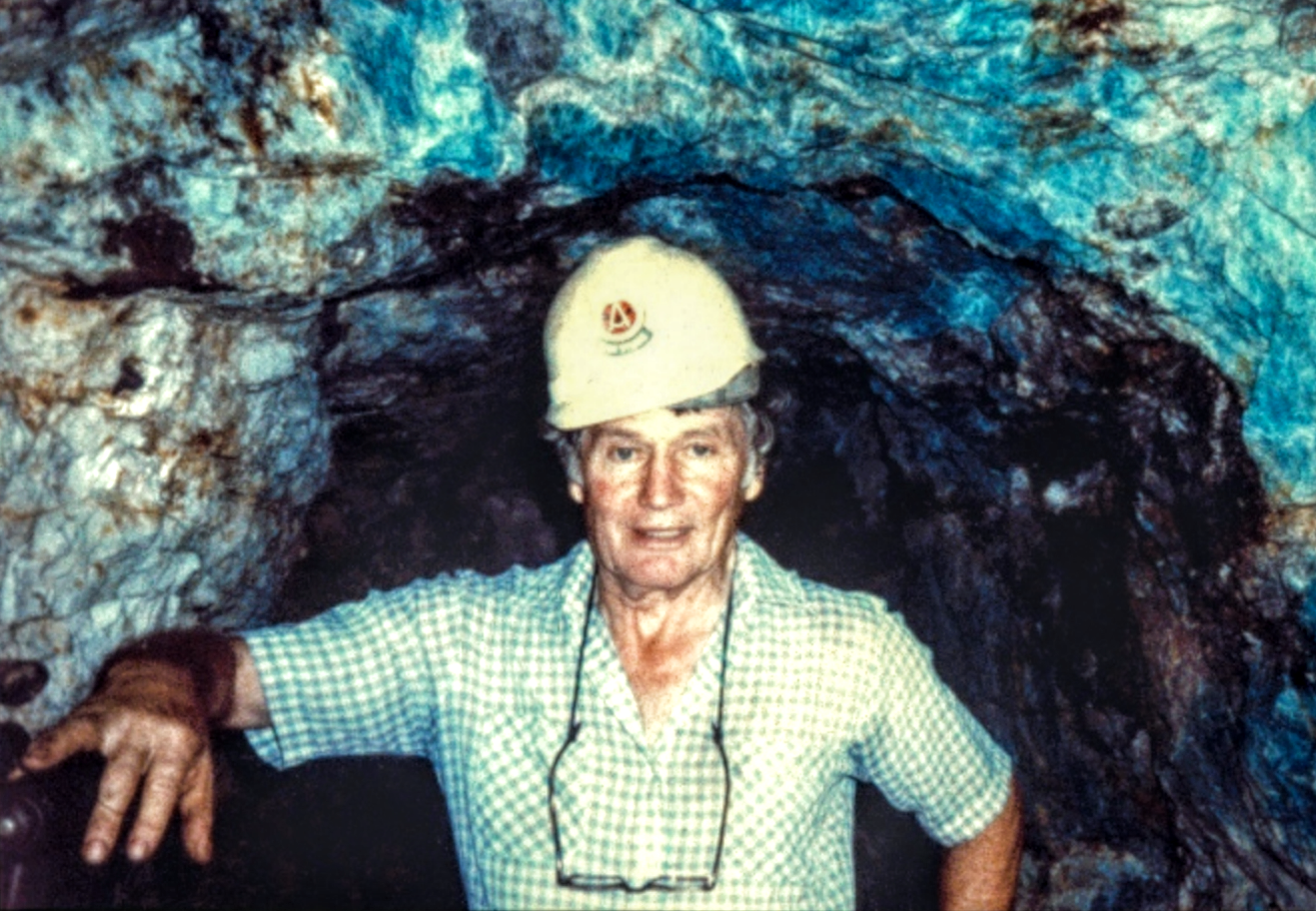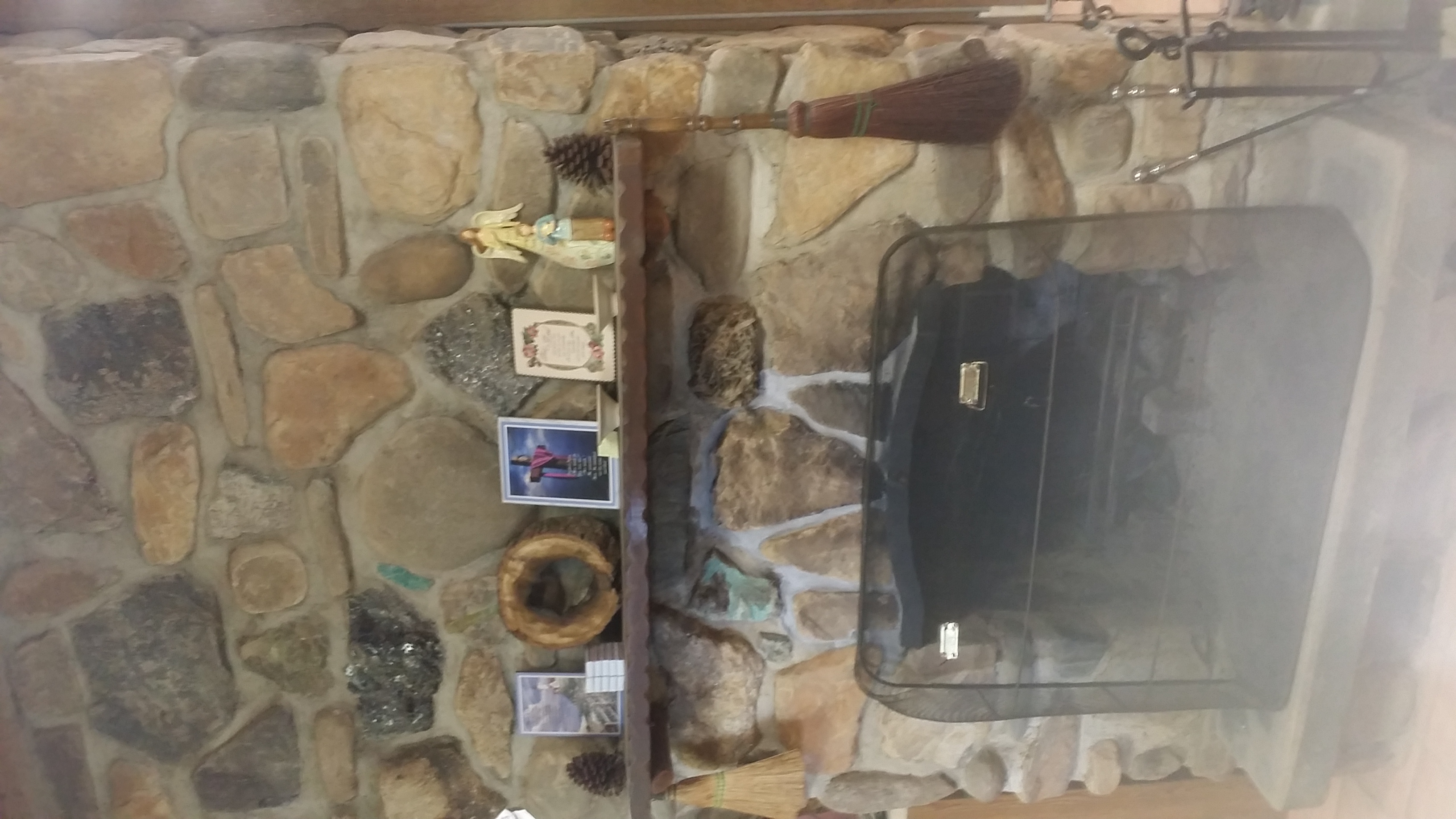Warren “Bill” Diehl Baltzley was born on January 29, 1922. Schabilion (2009) writes that Baltzley loved gem mining his whole life. After growing up in Fairfield, Pennsylvania, at some point he made it south to Amelia County.
 According to Schabilion (2009), Baltzley had moved to Amelia when he was a young man—in fact, “[b]esides running a rock shop, he operated the another large mine in Amelia, Rutherford Mine.” D’Orso (1988) is a little more precise, indicating that Baltzley quit high school after his sophomore year in 1940, to assuage a case of “mining fever.” He quotes Baltzley as having, “spent some time in this very hole,” referring to the Morefield mine. It seems Baltzley had left the copper hills in Pennsylvania, to search for mica in Amelia with his brother (1988, p. B2).
According to Schabilion (2009), Baltzley had moved to Amelia when he was a young man—in fact, “[b]esides running a rock shop, he operated the another large mine in Amelia, Rutherford Mine.” D’Orso (1988) is a little more precise, indicating that Baltzley quit high school after his sophomore year in 1940, to assuage a case of “mining fever.” He quotes Baltzley as having, “spent some time in this very hole,” referring to the Morefield mine. It seems Baltzley had left the copper hills in Pennsylvania, to search for mica in Amelia with his brother (1988, p. B2).
In the 1950s (D’Orso 1988) Baltzley learned the mica trade in Western North Carolina. While the years were not specified, several other roles Baltzley indicated he had held include emerald miner in South America, appraiser for the Russian government (Chapman 1990), diving for sponges in Florida and being a flight attendant (D’Orso 1988).
In 1957, the Rutherford Mine resumed mining, which, according to Kinkankas, had lain dormant since about 1943. Under the leadership of Baltzley, Rutherford no. 1 was bulldozed, to clear the rubble and overburden of the open-cut workings. Water was removed from Rutherford no. 2 and the mine was mucked out (Kinkankas 1968).
Baltzley Spessartites (sic). https://www.politicalavenue.com/108642/US-MAGAZINES/Rock%20&%20Gem%20-%20October%202016.pdf
Add this
http://www.tandfonline.com/doi/abs/10.1080/00357529.1957.11768571?needAccess=true&journalCode=vram20
He left the Rutherford Mine in 1958, when he lost his lease to the property from its owner, a Mr. Ezell Keener (Dunaway 2016).
Validation that he had lived in Amelia in the 1960s exists in a civil case, filed in his full given name, in federal district court; this article lists the address as “Rock Shop RFD2, Amelia” and he is referred to as “its operator” (Two Restaurants [1964?]).

Hereafter, Baltzley is often referred to as “Bill” or “William,” though his legal documentation appears to remain in his given name. Per Schabilion (2009), in 1969, Baltzley convinced a backer from near his hometown in Pennsylvania, Charles Rist, to support him in starting an emerald mine. Schabilion’s statement “Rist didn’t know anything about mining or emeralds, but was fascinated by Baltzley’s glowing accounts” foreshadows a trend seen throughout articles about Baltzley—it appears he had a gift at working a story.
At least two publications validate Baltzley’s references to emerald mining. In the Fieldtrip Guidebook: Hiddenite District Alexander Co, NC, Speer (2008) notes that “The property was opened as the Rist mine for prospect-for-fee in March 1969 and was operated by American Gems, Inc. from 1971 until 1982. Remarkable early discoveries mined from the shallow saprolite included [in] June 1969, [a] 250-carat 6” emerald found by William Diehl Baltzley, president of American Gems (Trapp, 1970; Sumner, 1972)” (p. 6). Brown and Wilson (2001) suggest that the “Carolina Emerald” was mined at the Rist/Ellis tracts in 1969 and that, as of 2001, the stone resided at the Tiffany’s showroom in New York City. D’Orso (1988) indicated that at one point Baltzley had owned the stone and that it was now owned by Tiffany’s, indicating that the stone was the largest cut emerald in North America, worth $150,000.
In a listing of the top 20 emeralds in North America (as of that date), Speer (2008) lists these two relating to Baltzley:
|
Rank |
Carats |
Name of Gem |
Mine |
Year |
Location |
|
9 |
1,215 |
Baltzley Twin |
North American Emerald Mines, Inc. |
1970 |
Smithsonian Institution (?) |
|
14 |
817.5 |
Baltzley Twin |
North American Emerald Mines, Inc. |
1971 |
Smithsonian Institution (?) |
“William Diehl Baltzley, deceased” is included in the list of discoverers and interim owners of these top emeralds (Speer, 2008, p. 5). Regarding the question marks (?) above, at search a press-time for these gem in the Smithsonian (2017) Institution database does not return any results of a match, when using either “North American Emerald Mines” nor its former name, “Rist Mine” as keywords along with “emerald” and “Baltzley.”
Brown and Wilson (2001) continued to clarify Baltzley’s timeline, indicating that American Gems, Inc., Baltzley’s partnership with Rist, continued through 1981. Another foreshadowing appears in this article: “During this period…there are no records of the amount or quality of production during this time, but it is generally known that many fine-quality specimens were obtained” (p. 129-140). In Rocks & Gems magazine, Dunaway (2017) noted that Baltzley’s leaving North Carolina coincided with the loss of his Rist partner to death.
Baltzley purchased Morefield mine in 1985 (Sweet, 1990, p. 92; Chapman, 1990), operating it as the Powhatan Mining Company.
On a more personal note, D’Orso (1988) indicated that Warren “Bill” Baltzley met Joan Elizabeth Dameron when she visited the mine as a Virginia Commonwealth University student three years before, which would have been about 1985. According to the article, they married “last year,” which would have been in 1987. As of 1988, Baltzley noted that Joan was working “at the county administrator’s office,” because “[s]omeone has to pay the mortgage” (p. B3).
In 1989, Warren Diehl Baltzley and Joan Dameron Baltzley together signed a lease allowing Martin Marietta to mine the majority of their acreage (State 1989).
Sweet (1990) noted that as of 1990, rock hounds were able to come sift through the dumps for a fee. Baltzley had installed a sluice box and was considering allowing digging in the pegmatite vein.
While his connection to the property is unclear, in 1992 Baltzley reported that could make arrangements for visits at a Fluvanna farm north of Kidds Store, that had light- to dark- pink rhodonite deposits that contained pyrolusite veins (Penick, 1992, p. 23). Baltzley operated this property during the time he owned Morefield mine.
Betsy Martin indicated that she all the history – “I even did some genealogy. I don’t know a lot about the man.”
As a miner at Morefield, it might be fair to say that Baltzley was more invested in above ground infrastructure and resources than in underground mining. Under his ownership, Morefield mine acquired a road back to the mine, a home which included his lapidary lab and museum [now the Morefield Gem Mine gift shop and museum], an open air blacksmith forge (D’Orso 1988), and a trailer (State 1989). A special, handmade feature in his combination home-retail store included a stunning rough-cut stone fireplace, peppered with chunks of amazonite and mica. It remains a commanding centerpiece to the Morefield Gem Mine store.

During the first four years (1986, 1987, 1988, 1989) for which the state of Virginia has records for Powhatan Mining Company, there was zero (0) tonnage reported. This is in contrast with D’Orso (1988), who wrote that, “Baltzley has pulled out plenty of stone in the last three years—about 275 tons by his rough reckoning” (p. B3). Perhaps the discrepancy related to some threshold under which reporting was not required. Regarding underground mining during the entire 11 reporting years he owned the mine, according to Virginia’s Division of Mineral Mining, Baltzley worked a total of 700 hours in the mine, or about 17.5 weeks’ worth of reported hours in total. During that time, he mined 1.5 tons, or about 3,000 pounds of material, with the first tonnage reported in 1990. [In contrast, Sam Dunaway mined 1,923 hours in his first 3 reporting years at the mine, generating 126 tons of reported material, or over a quarter million pounds of minerals.]
Perhaps Baltzley himself was conflicted with the notion of mining gemstones in a unique pegmatite such as Morefield mine; six years before he died, he said, “There aren’t many places in the world that are as colorful as this mine is, and it’s almost a shame to take it out” (Chapman, 1990, p. B3). You can perhaps see that play out with Dunaway’s ownership of the mine, as well; the most stunning Morefield mine finds are perhaps those seen still intact, tightly implanted in the chilly, water-soaked walls.
Baltzley (D’Orso, 1988) suggested that Morefield mine had hosted about 5,000 visitors in the year before the article, which would have included portions of 1987 and 1988. At that point, the day rate was $5 for adults and $3 for children. There were no mine tours at that point, because “the only person Baltzley allows underground is himself and occasional geologists” (p. B3). The daily rate had not increased by 1990, and 800 visitors came to the mine in June 1990 (Chapman, p. B3).
Ironically, D’Orso (1988) notes that “after all his searching and all his finds, Baltzley has nothing more to show for his adventures than [Morefield mine]…and that is enough.” In somewhat of a “somebody done somebody wrong song,” he writes that Baltzley, “has known loss—partners have swindled him, wives have left him, thieves have robbed him.” Yet he commented, “There’s enough here to justify the work I’ve done. Anything else is a bonus.”
Three years later, however, there were more significant finds during the Baltzley’s ownership of the mine. 1991 and 1992 brought two new species to the minerals known to be at Morefield mine, prosopite (July 1991) and pyromorphite (January 1992). Bill and Joan engaged Dr. Lance Kearns from James Madison University to identify the finds.
On September 1, 1991, Richard Seavey of Cumberland County made the find of his life—a 2,829 carat spessartine he dubbed the “Rutherford Lady.” Soon thereafter, Baltzley purchased this extremely gemmy orange stone; as of 1992, it was exhibited in the Morefield mine’s museum (Penick and Giannini, 1992, p. 15). Dunaway (personal communication, 4-15-2017) mentioned that Paul Jones, who still lives in Amelia, is the current owner of the Rutherford Lady. Paul felt an affinity to the stone, because he had grown up in a house next to the mine.
In March 1996, Baltzley sold Morefield mine to Sam and Sharon Dunaway. Bill passed away in Amelia Courthouse (the name of the town where Morefield mine is located) on July 13, 1996, aged 74, perhttp://www.ancientfaces.com/person/warren-baltzley/21447169.
Photo credits:
- Photo of Bill, from the personal collection of Betsy Martin. Used with permission
- Photo of fireplace, ©️2017 Karen Smith-Will
©️2021 to present ![]() Valutivity Press. All rights reserved.
Valutivity Press. All rights reserved.
